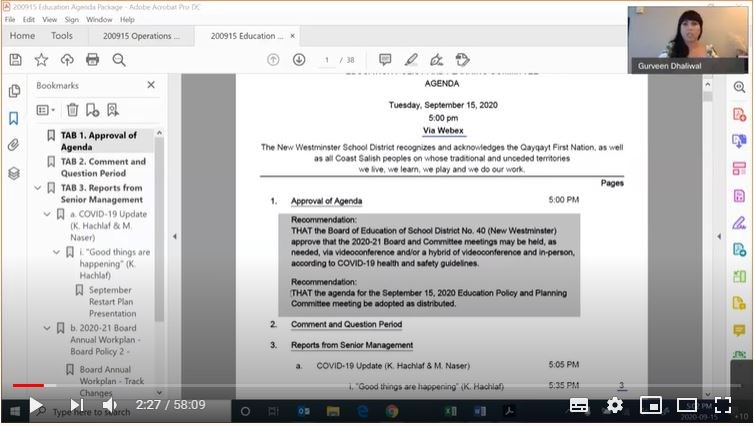New Westminster school trustees are considering moving to a hybrid meeting format that combines virtual and in-person attendance.
Trustees talked over the issue at their Sept. 15 operations committee meeting. That meeting, as with all school board meetings since the onset of the COVID-19 pandemic in March, took place virtually, on the Cisco Webex platform.
Secretary-treasurer Bettina Ketcham brought the issue forward to trustees along with a proposed schedule for board meetings. Trustees approved the new schedule, which will see one full public board meeting each month, along with one in-camera meeting and one evening with back-to-back education and operations committee meetings. (For the full 2020/21 meeting schedule, see here.)
But the larger discussion focused on how exactly those meetings should take place in the era of COVID-19.
“Many organizations and businesses have been propelled into rethinking and relooking how they want to conduct some of their more public meetings to engage stakeholders in different ways during the course of the pandemic,” Ketcham said.
If the board wanted to move back to in-person meetings, Ketcham noted, attendance would have to be capped at 50 and the board would need to move its meetings to a larger venue to accommodate physical distancing requirements.
She said the New West board’s move to virtual meetings has had some good outcomes.
“It has produced a very positive but unexpected result of having more engagement from the community,” she said. “It is refreshing to take some of the more real-time comments and engagement.”
Ketcham noted there are aspects of the digital meetings that can be “clunky” – such as sound issues that require participants to mute and unmute – and added staff has begun researching ways to modify the boardroom with technology to allow for hybrid meeting models.
A full videoconferencing retrofit would cost the district about $9,000, she said.
Superintendent Karim Hachlaf told trustees that the videoconferencing technology could be useful for district-wide staff meetings as well, so it would be used far more often than just a couple of times a month.
He told trustees that, from a staff perspective, a hybrid meeting would mean that at least some board members and staff would be present at the board office, in a physically distanced way, while others – along with members of the public – could take part virtually.
Trustee Anita Ansari led the charge for a hybrid model. She said a hybrid format would be useful to those who, like her, must be conscious of public contact – both because her employment is in an essential services setting and because her family life already brings her into contact with a large number of social circles.
“Within my bubble, I have two care societies – one after-school care and one child care – and I also have the school. I’m floating and peripheral to a lot of different kinds of risks. For me to add one more environment that I go to that I can find some way to work around would be great, because I don’t know if I can justify having me go from all these different places into another place,” she said.
Ansari said a hybrid model would also be useful to members of the public.
“It’s been difficult for parents in the public to come and to show up, especially if they have young kids. We know parents of young children are really, really interested when things come up to show up and to discuss, and I’d love to be able to offer some sort of virtual connectivity to them so that even if they’re doing bedtime, they can show up,” she said.
“I feel like, in this day and age, given the changes that we have gone through, having it be a hybrid and allowing a virtual point of access going forward is going to be something we have to consider for our community, because we don’t live the kind of lives that we can drop everything and show up in a space.”
Other trustees also expressed support for some type of hybrid model.
Trustee Gurveen Dhaliwal noted the limitations of technology, pointing out her own computer doesn’t handle long meetings well.
“That’s when the opportunity for a hybrid approach is just my preference, so I can be there in person,” she said.
In the end, trustees decided to bring the discussion back to their October operations committee meeting for a decision.



